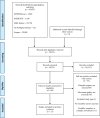The Role of Multi-Sensor Measurement in the Assessment of Movement Quality: A Systematic Review
- PMID: 37698766
- PMCID: PMC10687099
- DOI: 10.1007/s40279-023-01905-1
The Role of Multi-Sensor Measurement in the Assessment of Movement Quality: A Systematic Review
Abstract
Background: Movement quality is typically assessed by drawing comparisons against predetermined movement standards. Movements are often discretely scored or labelled against pre-set criteria, though movement quality can also be evaluated using motion-related measurements (e.g., spatio-temporal parameters and kinematic variables). Wearable technology has the potential to measure and assess movement quality and offer valuable, practical feedback.
Objectives: A systematic approach was taken to examine the benefits associated with multi-sensor and multiple wearable-device usage, compared with unimodal applications, when assessing movement quality. Consequently, this review considers the additional variables and features that could be obtained through multi-sensor devices for use in movement analyses. Processing methods and applications of the various configurations were also explored.
Methods: Articles were included within this review if they were written in English, specifically studied the use of wearable sensors to assess movement quality, and were published between January 2010 and December 2022. Of the 62,635 articles initially identified, 27 papers were included in this review. The quality of included studies was determined using a modified Downs and Black checklist, with 24/27 high quality.
Results: Fifteen of the 27 included studies used a classification approach, 11 used a measurement approach, and one used both methods. Accelerometers featured in all 27 studies, in isolation (n = 5), with a gyroscope (n = 9), or with both a gyroscope and a magnetometer (n = 13). Sampling frequencies across all studies ranged from 50 to 200 Hz. The most common classification methods were traditional feature-based classifiers (n = 5) and support vector machines (SVM; n = 5). Sensor fusion featured in six of the 16 classification studies and nine of the 12 measurement studies, with the Madgwick algorithm most prevalent (n = 7).
Conclusions: This systematic review highlights the differences between the applications and processing methods associated with the use of unimodal and multi-sensor wearable devices when assessing movement quality. Further, the use of multiple devices appears to increase the feasibility of effectively assessing holistic movements, while multi-sensor devices offer the ability to obtain more output metrics.
© 2023. The Author(s).
Conflict of interest statement
TAS received funding, which provided this author with a PhD stipend, from a project sponsor, Polar Electro Oy. The authors declare that they have no further known competing financial interests or personal relationships that could have influenced the content of this article.
References
-
- Camomilla V, Bergamini E, Fantozzi S, Vannozzi G. Trends supporting the in-field use of wearable inertial sensors for sport performance evaluation: A systematic review. Sensors [Internet]. 2018 [cited 2022 Sep 15];18:873. https://www.mdpi.com/1424-8220/18/3/873. - PMC - PubMed
-
- Clark CCT, Barnes CM, Holton M, Summers HD, Stratton G. A kinematic analysis of fundamental movement skills. Sport Science Review [Internet]. 2016;25:261–75. http://archive.sciendo.com/SSR/ssr.2016.25.issue-3-4/ssr-2016-0014/ssr-2....
-
- Clark CCT, Barnes CM, Holton M, Summers HD, Stratton G. Profiling movement quality and gait characteristics according to body-mass index in children (9–11 y). Hum Mov Sci [Internet]. 2016;49:291–300. https://linkinghub.elsevier.com/retrieve/pii/S0167945716301075. - PubMed
-
- Andrews JR, Fleisig GS. Preventing throwing injuries. Journal of Orthopaedic & Sports Physical Therapy [Internet]. 1998;27:187–8. 10.2519/jospt.1998.27.3.187. - PubMed
-
- Lyman S, Fleisig GS, Andrews JR, David Osinski E. Effect of pitch type, pitch count, and pitching mechanics on risk of elbow and shoulder pain in youth baseball pitchers. 2002. - PubMed
Publication types
MeSH terms
LinkOut - more resources
Full Text Sources


